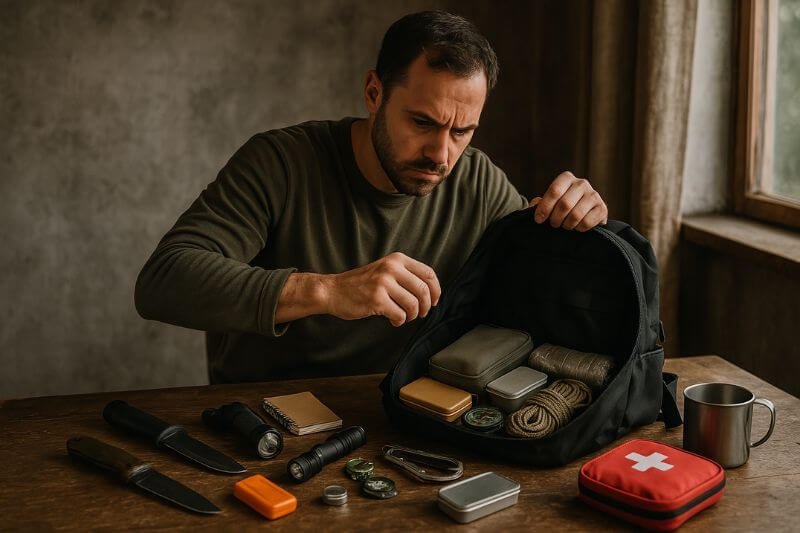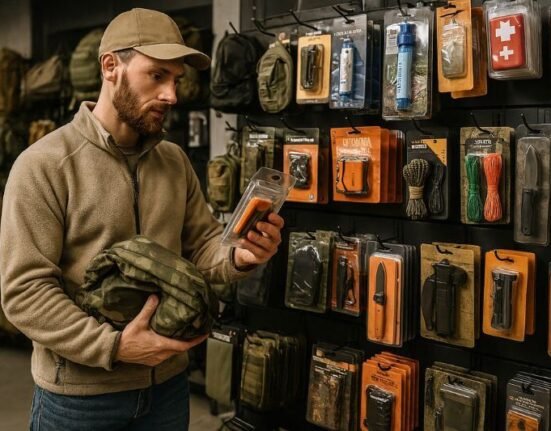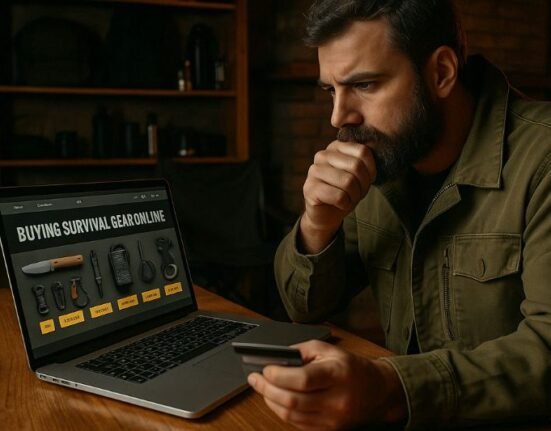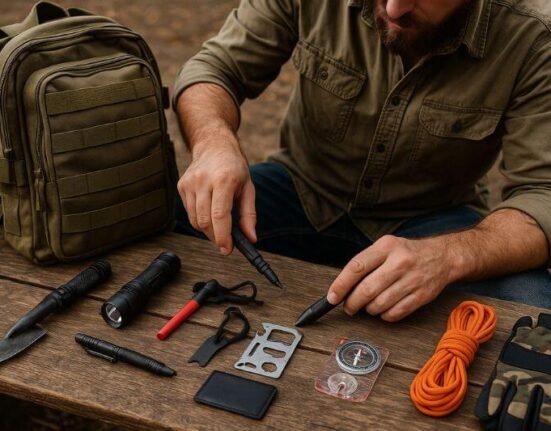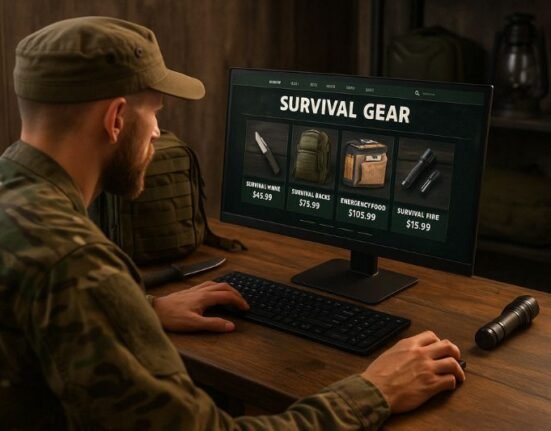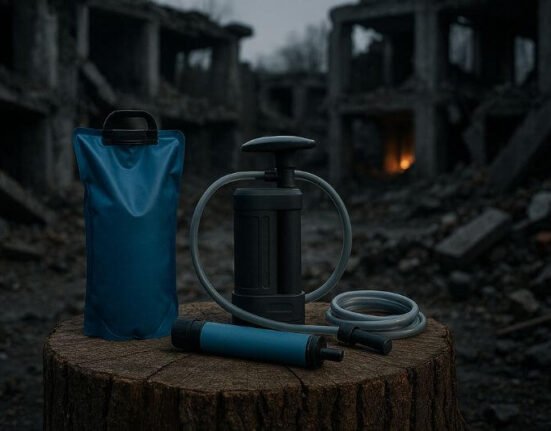In a survival scenario, your biggest asset isn’t your knife, your radio, or even your food rations. It’s your brain. Before you ever zip open your backpack or unroll your sleeping bag, your decisions—conscious or not—have already determined how well you’ll cope. This is where survival gear psychology enters the picture.
Understanding the psychology behind what we pack, how we prioritize, and why we sometimes fail to prepare effectively can be the difference between control and chaos. This guide explores how mindset shapes your survival kit—what you carry, what you forget, and what your gear really says about your survival readiness.
🧠 Why Psychology Is the Missing Piece in Most Prepping Guides
Most survival blogs focus on gear reviews, checklists, and bug out bag loadouts. That’s important. But what often gets overlooked is the cognitive engine behind the gear: your mindset.
The truth is, most packing mistakes aren’t logistical—they’re psychological.
Common examples of psychology-driven packing errors:
- Overpacking to ease anxiety
- Forgetting items due to avoidance (e.g. sanitation)
- Underestimating real threats due to optimism bias
- Misprioritizing gear because of identity or ego
You might have top-tier gear, but if you packed it based on emotional comfort instead of survival logic, you could be carrying dead weight—and missing lifesaving essentials.
🎯 Bottom line: Your brain builds your kit long before your hands do.
🧬 The Human Brain in Crisis: How We Actually Respond Under Stress
In emergencies, we don’t think clearly. Even trained professionals experience cognitive narrowing, where the brain filters out anything non-essential—often incorrectly. Here’s how the brain typically behaves under survival stress:
| Psychological Response | Survival Effect |
|---|---|
| Fight-or-flight mode | Tunnel vision, physical tension, quick decisions |
| Risk underestimation | Failure to prepare for less likely scenarios |
| Comfort-seeking bias | Overpacking sentimental or “feel-good” items |
| Gear fetishism | Obsession with cool gadgets, ignoring core needs |
| Paralysis by analysis | Indecision leading to no action at all |
This is why your gear should be pre-packed and pre-decided, not assembled under pressure.
🎒 Emotional vs Rational Packing: A Real-World Comparison
Let’s compare two fictional preppers to illustrate how mindset affects survival gear selection.
🧔 John – The Emotional Prepper
- Packs 3 knives “just in case”
- Carries his grandfather’s heavy military compass (no GPS)
- Brings a huge cooking kit but forgets a water filter
- Has 4 fire-starting tools but no first aid
Mindset: Fear-driven + nostalgic = heavy, redundant, unbalanced kit
👩 Lisa – The Rational Strategist
- Uses a minimalist 72-hour framework
- Water + food prioritized by shelf life and weight
- Includes trauma supplies + quick-access tourniquet
- Chooses dual-function tools (multi-tool, tarp, solar radio)
Mindset: Scenario-based + functional = efficient, flexible kit
This contrast shows why survival gear psychology matters more than gear brand or budget.
🔍 How Cognitive Bias Shapes Your Emergency Kit
Understanding cognitive bias helps you spot blind spots in your kit. Here are the most common ones in survival prepping:
1. Optimism Bias
“It won’t happen here. I probably won’t need this.”
- Leads to skipping first aid, backup power, or water filtration
- Fix: Pack as if it already happened
2. Availability Heuristic
“I saw a video about wildfires—I should prep for that.”
- Prepping is based on recent media not local threat data
- Fix: Use FEMA + Red Cross regional risk maps instead
3. Overconfidence Bias
“I’m fit, I’ll be fine with this heavy pack.”
- Overloading with unnecessary gear = fatigue, injury
- Fix: Field-test your bag on hikes with realistic terrain
4. Sentimental Attachment
“This knife was a gift, I have to bring it.”
- Emotional weight takes priority over function
- Fix: Respect meaning, but prioritize survivability
5. Novelty Bias
“Cool new gadget—I’ll toss it in.”
- Adds untested or redundant gear
- Fix: Only pack gear you’ve trained with
🔄 Mental Rehearsal: Train Your Mind Before the Crisis
Military and survival experts emphasize the value of mental drills. Why? Because your body reacts to what your brain expects.
Use this formula for better psychological preparedness:
🧠 S.E.T. Method:
- Scenario: Visualize the emergency (fire, blackout, storm, etc.)
- Environment: Imagine physical + emotional details (heat, panic, smell)
- Task: Walk through what you’d do, in order
Repeat this with your actual gear on hand. Mental rehearsal reduces cognitive load in real-time events, allowing faster, smarter responses.
🎯 If you can’t picture using it under stress, it shouldn’t be in your bag.
⚠️ The Role of Fear: Useful Fuel or Dangerous Saboteur?
Fear has two faces in survival psychology:
- ✅ Healthy fear: Motivates action, planning, and discipline
- ❌ Uncontrolled fear: Leads to hoarding, paralysis, poor choices
To manage fear effectively:
- Make packing a ritual, not a panic-driven event
- Use checklists and gear logs to stay grounded
- Keep a comfort item (photo, small memento) in your kit to stabilize mindset
🧠 Preparedness is the antidote to panic.
🧰 Aligning Mindset With Gear: Building a Kit That Matches Reality
It’s one thing to understand the psychological traps that lead to poor gear choices. It’s another to take that awareness and turn it into practical, resilient action. In this section, we move from theory to practice—showing how to build an emergency kit that reflects who you are, where you are, and what you’re realistically preparing for.
🎯 Step 1: Define Your Personal Risk Profile
Not everyone faces the same threats. The gear packed by a solo urban dweller in New York won’t be the same as a rural family in Montana.
✅ Ask yourself:
- What geographic threats do I face? (e.g. hurricanes, wildfires, civil unrest)
- What’s my mobility like? (on foot, car access, public transport?)
- Do I have dependents? (kids, elderly, pets?)
- Am I prepping for bugging in, bugging out, or both?
Your emergency kit should reflect your actual scenario, not someone else’s YouTube video.
🧭 Step 2: Use Scenario-Based Packing Logic
To override emotional or irrational gear choices, structure your packing around likely event types. Here’s how:
🔥 Crisis: House fire or sudden evacuation
- Psychological response: panic + urgency
- Gear mindset: minimal + mobile
- Priority items:
- Wallet + documents
- Flashlight
- 24h food/water
- Phone charger
- Emotional stabilizer (photo, routine object)
🌩️ Crisis: Storm or blackout
- Psychological response: frustration + uncertainty
- Gear mindset: comfort + continuity
- Priority items:
- Light sources (lanterns, headlamps)
- Power backup
- Food you know how to prepare
- Games/books to calm family
👥 Crisis: Social unrest or lockdown
- Psychological response: distrust + hypervigilance
- Gear mindset: stealth + safety
- Priority items:
- Grey-man gear
- Non-lethal self-defense
- Discrete communication tools
- Burner phone, cash, gloves
By naming the scenario, you guide your brain toward logic-driven decisions.
🧠 Step 3: Audit Your Current Gear With a Psychological Lens
Here’s a powerful exercise: Lay out your current kit. Look at each item. Ask yourself:
- Why did I really pack this?
- Have I ever used it in a drill?
- Does it solve a specific survival problem—or just make me feel “more prepared”?
You may be surprised how much of your gear falls into the “emotional padding” category.
🔄 Try this checklist to sort your gear:
| Gear Category | Rational Justification | Emotional Indicator |
|---|---|---|
| Compact multitool | Used for shelter, food, repair | Bought because “everyone has one” |
| Large hunting knife | Only useful if trained | Chosen for aesthetics or “badass” look |
| First aid supplies | Adapted to family needs | Overloaded or under-equipped due to fear |
| Fire starter options | 1–2 reliable tools | 4–5 redundancies due to panic or obsession |
| Tactical backpack | Neutral, durable | Military-style for “feeling prepared” image |
🧠 Audit your bag not just for weight—but for weight of intention.
📉 Avoiding Gear Creep: When Prepping Becomes Hoarding
Gear creep is the phenomenon where a bag that started as 15 lbs is now 50 lbs—and it’s not because you added essentials. It’s often a sign of fear replacing function.
Here’s how to fight it:
✅ Strategies to control gear creep:
- Limit yourself to 3 of each item type (e.g. light, fire, tools)
- Use a gear log: track how often you use/repack each item
- Practice a “one-in, one-out” rule: for every new addition, remove or justify
If your bag is overloaded, it won’t help you in motion-based scenarios. It becomes a psychological crutch rather than a survival asset.
🧠 Step 4: Use Color Psychology and Layout to Enhance Speed
Your brain operates faster when visuals are optimized. Use layout and color systems in your kit to reduce decision time.
🟦 Color-code your categories:
- Red pouch = trauma/medical
- Blue = water/filtration
- Orange = fire/heat
- Green = food
- Black = tools
This reduces panic in low-light or high-stress situations. You don’t have to think—just reach.
🧩 Layout logic:
- Top layer: fast-access survival priorities (light, fire, med, ID)
- Middle: food/water
- Bottom: clothing/shelter
🔦 Use your bag like your mind: the most urgent tools should be immediately accessible.
👨👩👧 Gear Psychology in Group Dynamics
In family or team scenarios, psychological factors multiply.
Common group mindset traps:
- “He has that covered, so I won’t pack it.” (false assumption)
- “We’ll stick together no matter what.” (optimism bias)
- “She doesn’t need to carry much.” (underestimation of capability)
Create redundant critical gear across members:
- Each person should have:
- Light source
- Emergency water
- Identification
- Basic first aid
Create psychological safety roles:
- One person focuses on navigation
- Another on morale (kids, pets)
- One manages comms/logistics
🤝 A mentally resilient group is stronger than the sum of its gear.
🎓 Tactical Drills for Cognitive Readiness
To make the right gear choices under pressure, you must train your brain, not just your hands.
Drill ideas:
- 60-Second Pull: Time how many useful items you can extract in 1 minute from your packed kit.
- Blind Bag Test: Pack your bag, blindfold yourself, and try to locate specific tools by feel.
- Stress Scenario Simulation: Do gear repacking after a 2km jog or in poor lighting to simulate fatigue + pressure.
These exercises imprint the layout of your kit into your muscle memory, reducing hesitation and errors when it matters most.
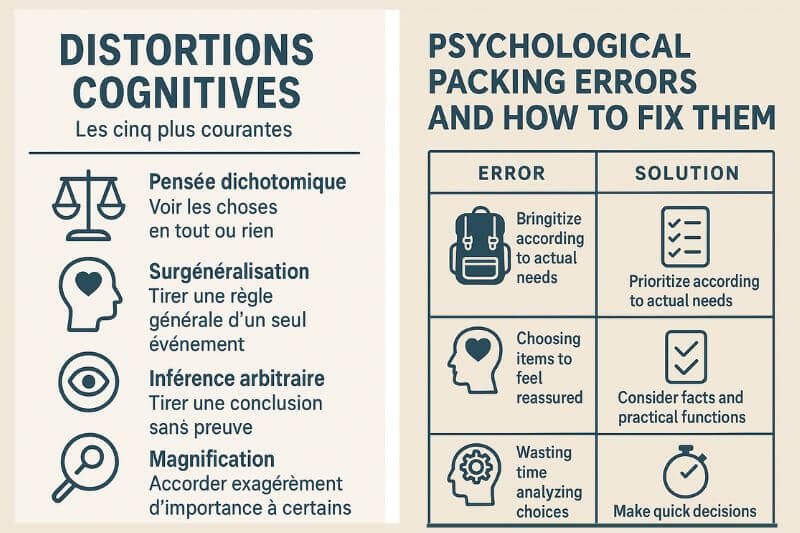
🧠 Who Are You When You Pack? Psychological Profiles of Preppers
Every survivalist packs based on who they are inside. Your personality, fears, habits, and beliefs all shape what ends up in your bag. By identifying your profile, you can adjust your approach, correct blind spots, and pack smarter.
Here are five common prepper psychotypes—and how to evolve them:
1. 🛠️ The Tactical Maximalist
“I need every tool, just in case.”
- Focuses on gear diversity, often duplicates functions
- Bag is heavy and slow
- May forget lightweight solutions or simplicity
Psychology behind it: Driven by control, often ex-military or security-oriented
Growth tip: Shift from “tool for every situation” → “skill that solves many problems”
2. 🎮 The Tech Reliant
“As long as I have my devices, I’m good.”
- Prioritizes GPS, power banks, apps, digital docs
- May ignore analog backups (paper maps, compasses)
- Vulnerable in power outage or EMP scenarios
Psychology behind it: Tech is a safety net, reducing cognitive load
Growth tip: Practice low-tech redundancy; do one bug out test without electronics
3. 🎒 The Gear Fetishist
“I research gear more than I train with it.”
- Obsessive about specs, brands, gear reviews
- Has high-end equipment… untouched in crisis drills
- Often builds identity around owning survival tools
Psychology behind it: Seeks confidence through acquisition
Growth tip: Use what you pack. Skills > gear. Limit time browsing, spend more time testing.
4. ❤️ The Emotional Stuffer
“I need my comfort things with me.”
- Packs sentimental items, comfort food, photos
- Can underpack critical survival gear
- Good emotional intelligence but risk-blind
Psychology behind it: Anxiety managed through emotional anchors
Growth tip: Keep 1 comfort item—but balance with practical tools. Train to find comfort in action, not objects.
5. 🧊 The Cold Rationalist
“I only pack what I can justify mathematically.”
- Efficient, streamlined kit
- Sometimes underestimates human needs (morale, warmth, recovery)
- May neglect group needs or psychological safety
Psychology behind it: Values logic, but disconnects from emotion
Growth tip: Integrate human-centered thinking—prepare for others, not just yourself.
🧭 In the Moment: How Your Mind Affects Real-Time Survival Decisions
All the best gear in the world won’t help if your decision-making collapses under pressure. Let’s explore how psychology plays out during a crisis:
🎢 1. Adrenaline and Tunnel Vision
Under threat, your prefrontal cortex (logic center) shuts down. You operate from instinct.
🧠 This means:
- Fine motor skills deteriorate
- Vision narrows (literally)
- You forget steps you’ve never practiced
Fix: Rehearse like it’s real. Pack gear where your body knows it is—so your hands don’t need instructions.
🕰️ 2. Time Distortion
In crises, time feels faster or slower. You might feel paralyzed even with a packed bag next to you.
Fix: Create muscle memory routines:
- Grab bag
- Check top 3 items
- Execute pre-defined plan
Drills override panic. Repetition builds clarity.
🎭 3. Identity Crisis Under Pressure
“I thought I’d be the leader… but I froze.”
What you imagine about yourself may not match how you act in crisis. That disconnect can be deadly—or demoralizing.
Fix: Test yourself with group scenarios:
- Who takes charge?
- Who panics?
- Who freezes?
Know your role under stress before you need to play it.
🔄 Building Psychological Resilience Over Time
Preparedness is mental stamina as much as logistics. Like any skill, it must be trained, tracked, and refined.
🧪 Weekly Micro-Drills to Train Your Psychology
You don’t need to bug out every weekend. Try 10-minute micro-tests:
- Pack check: Pull 3 random items, explain their purpose
- Scenario trigger: “A flood is coming—grab your gear in 60 seconds”
- Solo challenge: Navigate to a location with no phone
- Decision simulation: Choose 5 items for a surprise scenario
These build adaptive reflexes and decision endurance.
📆 Monthly Mental Maintenance Checklist
| Task | Purpose |
|---|---|
| Review gear and check expiry dates | Reduce uncertainty |
| Do 1 bag repack from scratch | Reconnect mentally with layout |
| Journal 1 imagined crisis | Build narrative rehearsal |
| Remove 1 redundant item | Strengthen decision clarity |
| Add 1 human-centered item (family photo) | Anchor emotional resilience |
📓 Preparedness isn’t paranoia. It’s intentional reflection + action.
🧠 Final Thought: Your Bag Is a Mirror
At the end of the day, your survival gear is a reflection of your psychology.
It shows what you value, what you fear, what you think you’ll need, and what you might be avoiding. When you lay out your gear, you’re also laying out your mindset.
So ask yourself:
- Does this bag reflect confidence or compensation?
- Does it align with my actual threats, or my emotional ones?
- Am I training with my gear, or just collecting it?
The more honestly you answer these questions, the more powerful your preparation becomes.
🧠 Your mind is your first survival tool. Sharpen it. Train it. Trust it.
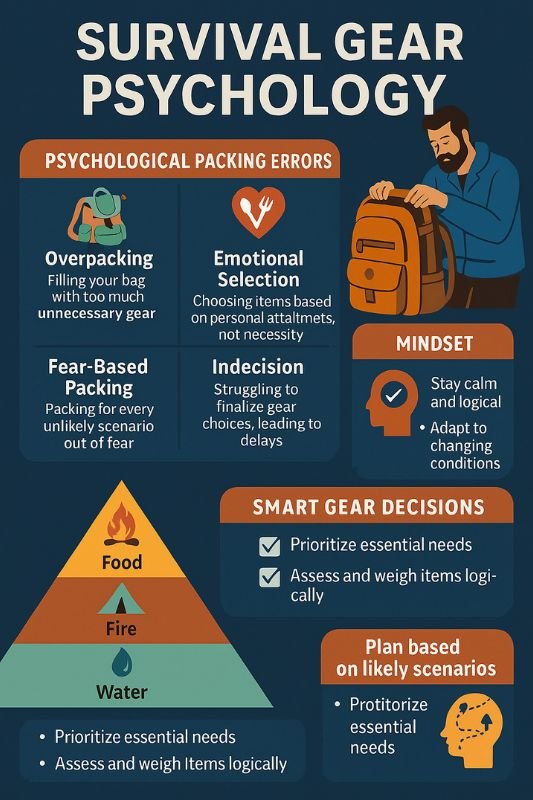
❓ Frequently Asked Questions (FAQ) – Survival Gear Psychology
Q1: Why does survival gear psychology matter if I already have a good kit?
Because your kit is only as good as your mindset when you packed it—and your ability to use it under stress. Survival gear psychology isn’t about second-guessing your gear; it’s about understanding why you chose what you did, and whether those choices hold up under real pressure.
Many people assemble excellent gear, but:
- Forget vital categories (like hygiene or comms)
- Overpack due to fear or underpack due to denial
- Can’t locate items in their bag during stress
- Don’t test or rotate their equipment regularly
Psychology explains these blind spots. It helps bridge the gap between what’s logical and what you’re emotionally drawn to, so you can build kits that work when your brain is tired, panicked, or operating on autopilot.
Q2: How can I tell if I’m packing gear for comfort instead of survival?
Start by auditing your current kit item by item. For each object, ask:
- Is this essential for survival, or is it here to make me feel better?
- Do I have duplicates that serve no added survival value?
- Have I used or trained with this item before?
- Could I realistically deploy this under stress or in low light?
Common comfort items include:
- Excessive cooking gear for “camp-style” meals
- Sentimental tools or weapons with emotional value
- Gear inspired by entertainment (e.g. movie-style gadgets)
- Overbuilt kits that match identity, not function
This doesn’t mean comfort is bad—it’s essential for morale. But it should be intentional, not accidental. A single emotional anchor like a family photo or a favorite snack is healthy. Fifteen pounds of “feel safe” gear is not.
Q3: How do I avoid panic-packing during a real emergency?
Panic-packing is one of the top causes of missing essentials and forgetting basics. In high-stress moments, the prefrontal cortex (decision center) shuts down and defaults to instinct. That’s why decisions must be made before the crisis starts.
Here’s how to avoid panic-packing:
- Have a pre-packed bag that’s ready to grab
- Run through mental rehearsals regularly (e.g. “fire drill” scenarios)
- Keep a printed checklist of what to pack if you have 5 minutes, 30 minutes, or 1 hour
- Assign packing roles in group or family scenarios
Most importantly, trust the logic you built into your kit in advance. If you planned it while calm and informed, don’t let chaos trick you into impulsive changes. Fear-driven packing leads to imbalance—too much of one thing, none of another.
Q4: What psychological traps should I watch out for when buying new gear?
Excellent question—consumer psychology plays a major role in how survivalists build their kits.
Here are key psychological traps to watch out for:
- Gear Envy: Wanting a tool just because it’s popular in the community or a favorite YouTuber reviewed it
- Novelty Addiction: Being excited by new tech without assessing usefulness or training for it
- Identity Validation: Choosing items that make you feel more prepared (military, tactical, flashy) rather than more effective
- Overcompensation: Packing for unlikely scenarios because of fear or guilt (“what if I’m not ready for XYZ…”)
Fixes:
- Always match gear to a specific survival use-case
- Follow the one-in, one-out rule: Don’t add something without removing something else
- Budget for training time, not just purchases
- Ask: Would I bring this if I had to carry it for 10 km?
This shifts your mindset from collector to practitioner—which is exactly what you want in real-world prepping.
Q5: How can I mentally train to use my gear effectively under stress?
This is where survival gear psychology becomes a skillset, not just a theory. You need to develop muscle memory, decision flow, and emotional conditioning. Here’s how:
✅ 1. Repetition under mild stress
- Practice assembling your gear after a workout, in low light, or with time pressure
- Run gear drills with gloves on (simulating cold or injury)
- Unpack and repack your kit by memory
✅ 2. Scenario-based walk-throughs
- Visualize yourself using your kit during:
- A night evacuation
- An injury in the field
- A solo bug out scenario
- Build a mental map of your bag’s layout—where each tool lives, what’s most accessible
✅ 3. Train decision-making
- Practice choosing between tools (“knife or multitool?”) based on situation
- Force prioritization: If you could only take 10 items, what are they?
✅ 4. Psychological reinforcement
- Keep a log of gear-based wins (“used my water filter on hike X,” “improved shelter speed by 3 min”)
- Celebrate small progress milestones—this builds confidence, not just competence
💡 Remember: The goal isn’t perfection. It’s to close the gap between who you are in theory and who you’ll be when it counts.









